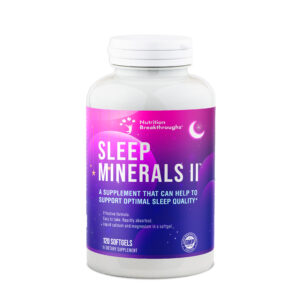 Sleep Minerals II is one of the most effective all-natural insomnia remedies. It’s the original drug-free calcium and magnesium formula for better sleep. It calms sleeplessness and helps you to relax, fall asleep, and sleep deeper.
Sleep Minerals II is one of the most effective all-natural insomnia remedies. It’s the original drug-free calcium and magnesium formula for better sleep. It calms sleeplessness and helps you to relax, fall asleep, and sleep deeper.
The ingredients are formulated in a softgel with healthy oils, making them more quickly absorbable than tablets or capsules and providing a deeper, longer-lasting sleep. Sleep Minerals II is also a proven remedy for restless leg syndrome, menopause insomnia, teenage insomnia, stomach health, strong bones, and correction of calcium and magnesium deficiencies
Alex R. of Ramseur, North Carolina says: “Sleep Minerals II has been a blessing for me. It has given me the opportunity to withdraw from a highly addictive sleep medication over time, and has allowed me to sleep while going through this most difficult ordeal. What’s great about it is it doesn’t lose its effectiveness, which is something that happens with sleep medications. I am most thankful for this product.”
Kimberly B. of Troy Michigan says: “I have been taking Sleep Minerals II for about a month now. I have tried everything out there and this supplement is amazing. I have suffered with insomnia for two and a half years and have had restless leg syndrome my entire life. This is the first relief I’ve ever had…it’s gone for a month now.”
Anne and Bob B. of El Dorado Hills, California says: “We find the Sleep Minerals very helpful for my husbands restless leg syndrome. He does not do well on many medications and the drug the doctor prescribed for this was full of bad side effects. Out of pure desperation, I researched the internet and came up with an article about Sleep Minerals II and decided to try them. They have been wonderful. Bob continues to sleep much better and with very little, if any, movement in his legs.”
Richard P. of Parkville, Maryland says: “The Sleep Minerals are making quite a difference. I was regularly waking at around 3:00 a.m. and after a few days use of taking two, my sleep improved quite a lot. I wake once a night to go to the bathroom, but the great thing is, I then fall back asleep and sleep several more hours. This has been a great improvement.”
Anita L. of New Caney, Texas says: “I was having hot flashes every 30 minutes to an hour through the night and was so miserable. After about two weeks of taking the Sleep Minerals, I noticed an incredible difference with my sleep. I have much less interruption from flashes, I’m sleeping much better and I’m a lot more comfortable.”
Valerie H. of Santa Clarita, California says: “I had such severe menopause insomnia it took me hours to fall asleep even though I was extremely tired. My legs also had crawling and tingling feelings at night. I got the Sleep Minerals and after several days, it started to work really well. I fall asleep now within 20 minutes and no more restless legs.”
L.R.C. of Massachusetts says: “I had become dependent on sleeping drugs and couldn’t sleep without them. Now I take the Sleep Minerals before bed and I can sleep through the whole night without drugs. I’m also able to easily fall back to sleep if I do have to get up. Another benefit is it helps alleviate my chronic fatigue and aches and pains.”
For more information on Sleep Minerals II click here.




